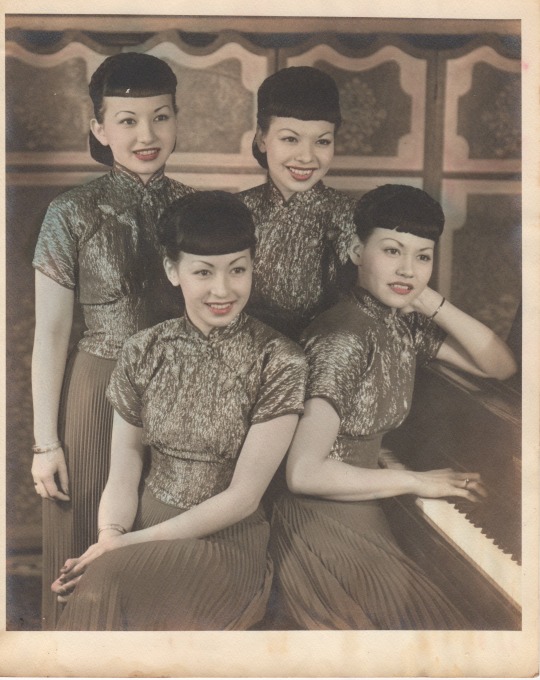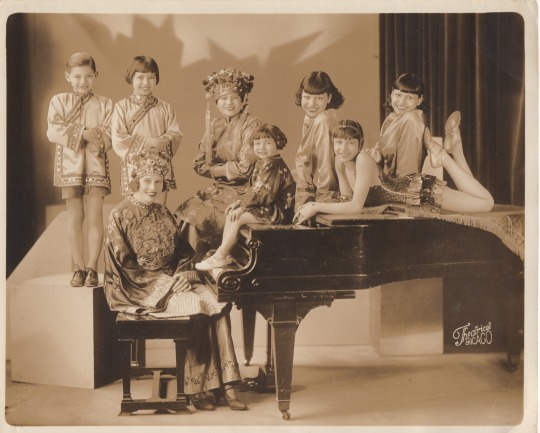Conversations | Leslie Li’s “The Kim Loo Sisters”
“It was no small feat to break out of the ‘chop suey circuit’ and share top billing on the Broadway stage and the Hollywood screen with Frank Sinatra, Ann Miller, Jackie Gleason and The Three Stooges, particularly at a time in America when there was strong anti-Asian sentiment.”
They are Alice, Maggie, Jenée, and Bubbles—the four Chinese American sisters that illuminated the Hollywood and Broadway musical scene in the 1930s and 1940s. Acclaimed as the “Chinese Andrew Sisters,” these women and their never-before-told memoir give us a new look at the cultural landscape of mid-century U.S. while shedding light on today’s timely issues of immigration and cultural identity.
Leslie Li, an award-winning novelist and daughter of Jenée, chronicles the sisters’ legacy in a new book and in her very first documentary film, The Kim Loo Sisters. Fiscally sponsored by NYFA, Li’s film brings together interviews, old archival footage, and home videos to share the sisters’ remarkable journey through the entertainment industry. Read our interview with Li as she discusses the making of the film.
NYFA Current readers are also invited to two private screenings of the The Kim Loo Sisters.
Boston Screening
When: October 27, 2017, 6:00 PM
Where: Pao Arts Center, 99 Albany Street, Boston, MA 02111
Washington, D.C. Screening
When: October 29, 2017, 1:30 PM
Where: Chinese Community Church, 500 I Street, NW, Washington, D.C. 20001
RSVP is required for both screenings. Please email Leslie Li at [email protected] to be included on the guest list (first 10-12 guests).
NYFA: How and why did you decide to share and chronicle the Kim Loo Sisters’ story?
Leslie Li: Two of my books—the novel Bittersweet (Tuttle Publishing) and the memoir Daughter of Heaven (Arcade Publishing)—are about the paternal and political side of my family. I wanted to write a book about the maternal and performing arts side of my family. However, I knew very little about the lives of my mother and her three sisters as young women—only that they were known as the Kim Loo Sisters and appeared on stage as a jazz vocal quartet in the 1930s and 40s. That didn’t seem like it was substantial enough, or significant enough, for a book or a film.
But in 2007, I began to do some research to see if there was more to their story. I interviewed all four women—Alice, Maggie, Jenée and Bubbles, all in their late eighties and early nineties—sifted through mountains of their theatrical memorabilia, and read as much as I could about the entertainment industry of that era. What I discovered (and what the Kimmies themselves didn’t know) was that the Kim Loo Sisters, daughters of a Polish dressmaker and a Chinese waiter, were the first Asian American act to star in Broadway musical revues. It was no small feat to break out of the “chop suey circuit” and share top billing on the Broadway stage and the Hollywood screen with Frank Sinatra, Ann Miller, Jackie Gleason and The Three Stooges, particularly at a time in America when there was strong anti-Asian sentiment.

NYFA: As an acclaimed novelist, you are not only making a film but also writing a book on the Kim Loo Sisters. What made you choose to utilize both mediums? What can a film do that the book cannot? Conversely, what can the book do that the film cannot?
LL: My original intention was to write a book about the Kim Loo Sisters called Just Us Girls. The idea of a feature-length documentary surfaced only as I dug deeper into my mother’s and aunts’ closets, attics, and basements and unearthed 16mm reel-to-reel home movies, tape recordings of them singing some twenty songs, clips from their feature and short Hollywood films; publicity photos, theatre programs and reviews, and other ephemera. I found a treasure trove of visual and aural artifacts—the stuff that films are made of. So Just Us Girls, the written work, had found its filmic counterpart: The Kim Loo Sisters, the documentary. Though I’m a writer and I’d never made a feature-length film before, I knew I had to do it. The story was just too important and, as it turns out, too timely and relevant not to do it.
The film and the book are the same in content but different in format. The book comprises written words; it contains all the interviews, edited, that I conducted of the sisters and a smattering of photographs. The film, on the other hand, comprises just a fraction of those words in spoken form—bits of the Kimmies’ interviews and some voice-over narration. The lion’s share of the film, however, is composed of visual and aural material: singing, dancing, music, movie clips, photographs, even animation. That’s what a film is. It’s images and sounds. And what both mediums offer—the audience in the film’s case and the reader in the book’s case—are different as well. The film has more “entertainment” value because it appeals to the senses; sight and hearing. The book is more interior, evocative. “The written word,” the writer Annie Dillard wrote, “appeals only to the subtlest senses—the imagination, the moral sense, and the intellect.” That’s not to say that one medium is better than the other, only that each demands and delivers different things and delights in different ways and in different degrees. Hopefully, both Just Us Girls and The Kim Loo Sisters accomplish all three.
NYFA: The film narrative spans over a century including the Jazz Age, the Great Depression, and the Second World War. It also focuses in on the diversity of experiences and personalities of the four sisters—Alice, Maggie, Jenée, and Bubbles. What are the overarching elements and themes that weave the narrative together?
LL: The Kimmies cut their theatrical teeth in Minnesotan kiddie revues during the Jazz Age, trod the boards on the national vaudeville circuits as a family act during the Great Depression, and lit up the Broadway stage and the Hollywood screen during the Second World War, when they also joined the USO to entertain American and Allied troops stationed in Europe. For me, the overarching elements and themes of the film are family loyalty, sisterly love, and the search for and the realization of one’s dreams against great odds and obstacles. The film also serves as a prism shedding light on the issues of ethnicity, cultural identity, immigration, and race; issues that impacted the Louie family almost a century ago and that are just as, if not more, pressing and controversial today. I should add that I had no idea that these critical issues played a significant part in the lives and careers of the Kim Loo Sisters until I was well into making the film.
Others who saw the documentary interpreted it differently. A filmmaker found parallels between the Kimmies then and Asian American actors now, citing the perpetuation of Asian stereotypes in the movies, the lack of minorities nominated in any category in last year’s Academy Awards, and the fact that the few roles written for Asians are likely to be “white-washed” to fit Caucasian actors. My mother was considered for the role of Olan, the Chinese peasant wife in the film The Good Earth, for example, but the role went to the Viennese actress Luise Rainer. A journalist, music critic, and author praised the Kimmies’ stage presence and vocal talent, saying, “Such a shame they weren’t recorded. They had an amazing sound. An electrifying charisma…” One Chinese American woman described the film as “a love letter to your family.” An Indian American woman felt that The Kim Loo Sisters was about “the history of jazz performances, immigration, assimilation, Orientalism, biases towards women, exoticization of Asian identities and personal struggles, sacrifices and perseverance… told with tenderness and fun.” A woman in Vermont felt that the film was an important chapter in American history of which she was completely unaware, that the film was “education disguised as entertainment.” I was delighted by the wide-ranging feedback and gratified that the film didn’t elicit a single response or a pat interpretation. To me, it meant that the film has subtext, leaves something for the viewer to infer. It meant that the film is “generous” in the Sartrean sense—that is, that it will mean different things to different people based on their own life experiences, sensibilities, and personal values.

NYFA: How does the film shed light on the Chinese-American experience in the 1920s-1940s?
LL: In many ways, the Kimmies were no different from the Scandinavian Americans with whom they grew up and went to school in Minneapolis, MN. They ice-skated in Powder Horn Park, they attended the high school senior prom (even providing the entertainment!), they danced the Big Apple and sang American jazz (and were paid for it!). But they shared far more significant similarities with all Chinese Americans at that time, the same concerns and experiences stemming from racial prejudice. For example, the Chinese Exclusion Act of 1882 barred Chinese laborers—of which their father was one—from entering the United States. Shear Gim, like many Chinese workers, evaded this restriction by becoming a “paper son,” that is, by obtaining falsified documents certifying that he was the son of an American citizen. Fearing deportation, all his life he had to be guarded and secretive. And he never left the U.S., terrified that he would be denied re-entry.
The Kimmies, though born and raised in America and whose mother was white, were subjected to racial profiling. Being of Chinese descent, they had to register with the Immigration and Naturalization Service, where a file was kept on their comings and goings to and from the United States. They suffered the indignity of being thrown off a train by an “overzealous” conductor at the border of the United States and Canada, where they had just performed. They were denied housing in Chicago and rooms in better hotels in the South. Not strictly targeting Chinese Americans but all racial minorities, Hollywood’s Hays Code dashed any hope that Jenée, my mother, might be cast as Olan in The Good Earth. Once Paul Muni, an Austrian actor, was chosen to play the protagonist Wang Lung, it was a foregone conclusion that a white actress would receive the role of his wife Olan, since the Hays Code prohibited “miscegenation” or any romantic interaction between actors of different races. Speaking of miscegenation, anti-miscegenation laws prevented my aunt Bubbles from marrying her fiancé Stuart Foster in California, one of the 16 states that forbade interracial marriage. If such incidents of racial discrimination happened to the Kim Loo Sisters, they undoubtedly happened to other Chinese Americans and other minorities, as well.
NYFA: What are the next steps for the film?
LL: The Kim Loo Sisters has been shot and edited, thanks in large part to editor Harry Keramidas (who edited, among other films, all three episodes of the iconic Hollywood trilogy Back to the Future) and associate editor Tony Jillson, who is also responsible for the animation and incidental music. We’re now in the process of raising post-production funds to pay for licenses to the songs the Kimmies sing in the film, permissions for the archival film footage, sound mix, and color correction. We’ve got screenings planned for Boston, Los Angeles, and Washington, D.C. We’re also gearing up to launch another crowdfunding campaign similar to the one we mounted in the summer of 2015 where we raised enough funds to buy several songs’ licenses. This time we want to raise enough money to buy them all!
To date, we’ve screened The Kim Loo Sisters in San Diego, San Francisco, Chicago, the Twin Cities, New York, Saxtons River, VT, and Ashfield, MA, not only to raise funds but also to build a large and loyal community around the Kimmies who, by the way, have the honor of being included in the recent year-long art installation at Gracie Mansion, New York’s mayoral residence. Not bad for four sisters whose former residence in New York was an efficiency apartment in Hell’s Kitchen!
NYFA: Why did you choose NYFA Fiscal Sponsorship?
LL: Many, if not most, private donors and grant givers require artists to obtain 501(3)© status or the sponsorship of an organization with that status. Based on a bit of research, word of mouth, and its long history and impressive track record, I chose New York Foundation for the Arts as my fiscal sponsor. After meeting Matthew Seig, NYFA’s Media Specialist, and attending an event where he was one of the panelists, I knew I’d come to the right place. Without his guidance, support and encouragement and that of NYFA’s staff, I’m not sure I would have applied for, and been awarded, grants from New York State Council for the Arts, the Lower Manhattan Cultural Council, and the Chinese Heritage Foundation. The application process can be quite daunting! It seems whenever I found myself needing advice on a specific grant application or on my responsibilities and rights as a filmmaker, Matthew would supply it, always encouraging but never underestimating the potential obstacles that might lie in the path of a traditional music history documentary filmmaker. He told me, “I think there are stories that defy the ability of a short trailer or synopsis to adequately do them justice, and you may have one. [The Kim Loo Sisters] is [a traditional music history documentary], and a family story, and a story about both social and cultural history, and also an interesting story about being artists in America. But I’m not sure how you can quickly get any of that across [to donors and grantors] in a way that makes it sound anywhere near as fascinating and entertaining as it is.”
Leslie Li is the writer/producer/director of The Kim Loo Sisters, her début feature-length film. She is the author of four books: Bittersweet: A Novel (Tuttle Publishing); Daughter of Heaven: A Memoir with Earthly Recipes (Arcade Publishing); Enter the Dragon: A Book of Children’s Plays Based on Three Chinese Folktales (Main Street Arts Press); and Just Us Girls: The Companion Book to The Kim Loo Sisters (Four Seasons Press). Her novel and memoir have been translated into five languages. She received a New York State Council for the Arts Individual Artist Grant, a Lower Manhattan Cultural Council Grant, and a Chinese Heritage Foundation Grant for The Kim Loo Sisters documentary as well numerous fellowships and grants for her published work, including a Freeman Foundation Grant; Leo Maitland Fellowship at the Millay Colony for the Arts, Austerlitz, NY; The Cottages at Hedgebrook Writing Residency, Langley, WA; and Fondation Ledig-Rowohlt Writing Residency, Lavigny, Switzerland.
– Interview conducted by Priscilla Son, Program Assistant, Fiscal Sponsorship & Finance
NYFA Fiscal Sponsorship’s next quarterly no-fee application deadline is December 31, and you can learn more about NYFA Fiscal Sponsorship program here.
Images: Kimmies, James Kriegsmann, 1939; Kimmies at Piano, Courtesy of Leslie Li; Louie’s Chinese Revue, Chicago Theatrical





